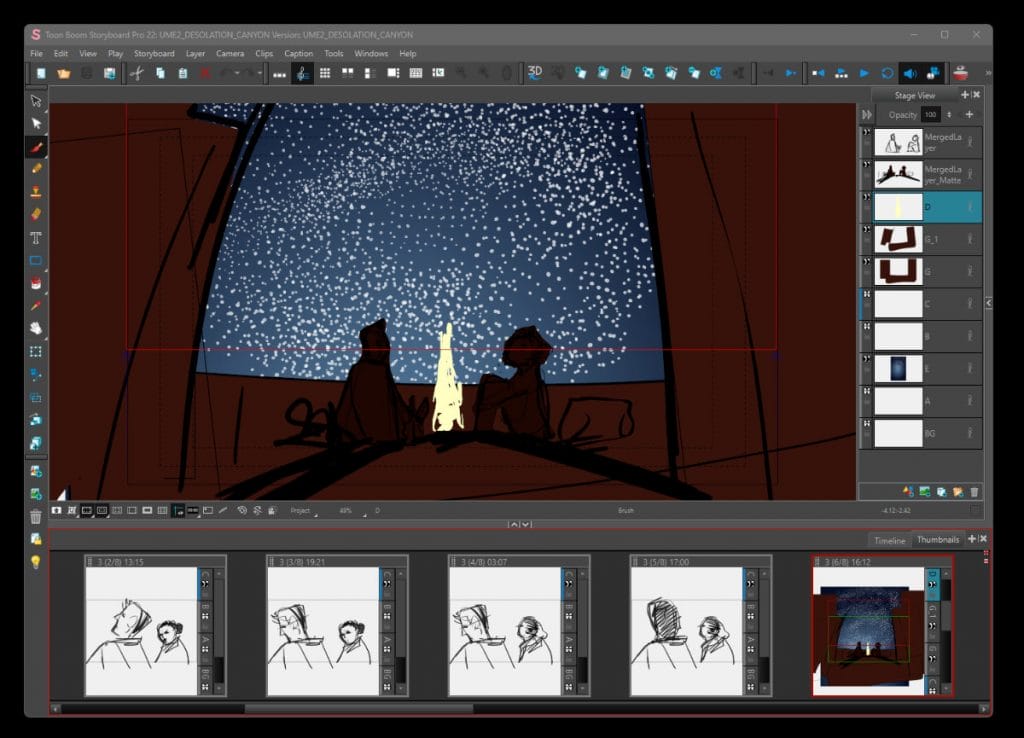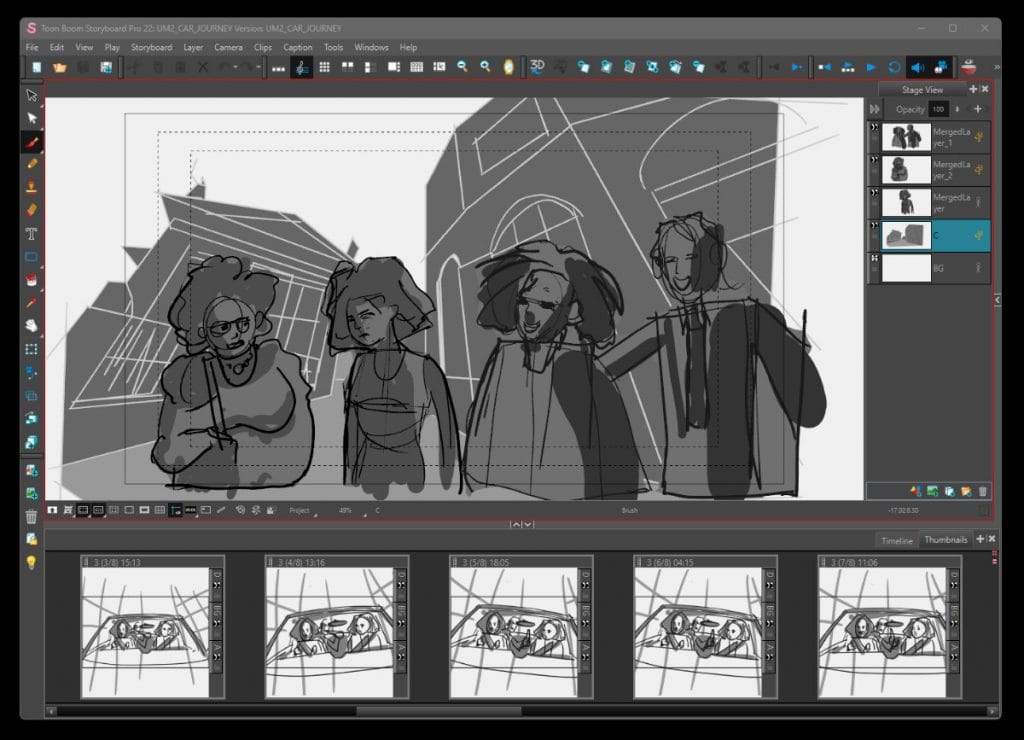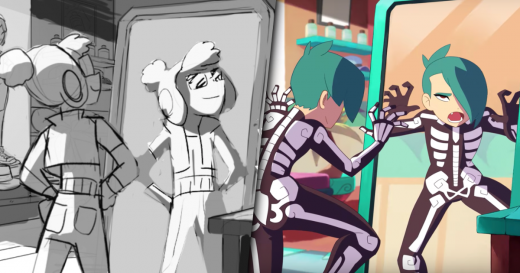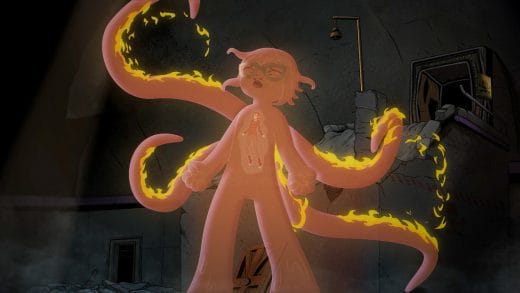
One silver lining of the pandemic is that our collective memory continues to inspire artists. From stories of bravery, sacrifice and perseverance, to love stories made more poignant through the lens of long-distance, interpersonal restrictions and lives changed forever. One such story is U.Me: The Complete Musical, written by Simon Pitts and Theo Jamieson. U.Me is a musical told in vivid animation by Dan Masterton and his team at The Mighty Pie Creative Studio. In the musical, two lovers are brought together by the internet amidst a world upturned. Broadcast on the BBC, the show delivers a unique animated style, given added star-power by voice acting from Anoushka Lucas, Martin Sarreal and Stephen Fry.
Following their meeting on video conferencing software at their remote jobs, protagonists Rose and Ryo come together in a modern love story for an audience where the everyday functions, rituals and expectations of life and love have been framed by video calls. Reflecting this contemporary feel is a stylised mixture of animation, including 3D, 2D, motion graphic and hand-drawn animation. With Storyboard Pro, Dan employed what he refers to as “live storyboarding”, a spontaneous and freehanded approach that conjures emotion for the drama.
We spoke with Dan Masterton about his special approach to this unique story. Dan shares fascinating insights from U.Me’s production, including working remotely with the London Philharmonic Orchestra on the soundtrack. He also shares some of the challenges that working during lockdown posed, and how they were overcome by the team’s resourcefulness, passion and creativity. See the trailer for U.Me: The Complete Musical and read our full interview with Dan Masterton below…
In a short summary, please introduce the story of U.Me.
Dan: U.Me: The Complete Musical is a story about two people who fall in love across the internet during the pandemic. The first half is during the pandemic, and the second half is dealing with life afterwards. It’s a very real story, I think everyone will be able to relate to it in some way.
Stephen Fry is the narrator, and the characters of Rose and Ryo are played by Anoushka Lucas and Martin Sarreal. Their performances are incredible. The story was originally conceived by Simon Pitts and Theo Jamieson. The music was performed by the BBC Philharmonic orchestra, and it was mixed by the fabulous Steve Levine.
The first half, which is around an hour, was all created during lockdown, so you can imagine all of these people creating and communicating without being able to meet, it was a feat on its own. And us, The Mighty Pie Studio, to direct and create the animation. There are so many people with integral parts, you’ll see in the credits. Everyone put in their all to create something really special.
Can you introduce the key characters and their stories?
Dan: Rose is a girl in her twenties. She grew up looking after her sister, while her mother was busy working. Eventually, her sister went to uni, so Rose moved to her dream town of London. A few weeks after arriving, lockdown hits, and she’s stuck in her flat with nowhere to go.
Ryo lives in Kyoto. He’s also in his twenties and works at the same company as Rose. They meet in a video conference, and pretty much hit it off straight away due to their similar personalities.

What was the process of character design?
Dan: Most of the main characters were based on their real-life counterparts. I wanted them to be instantly emotive and appealing, though somewhat realistic in proportions. If they’d been too cartoony, the music wouldn’t have worked, and the more serious parts would have failed.
On the other hand, some of the characters were designed to physically resemble their role in the musical if that makes sense. A big personality really needs a big character with a lot of presence, and vice versa.
How would you describe the style of animation you have used in U.Me?
Dan: I simply call it stylised animation. It’s a mix of 3D animation, 2D animation, motion graphics, hand drawn, everything really.
One aspect we considered early on was that all films nowadays must have subtitles. Rather than the box with text underneath, we decided to make the words part of the animation. Andy Peach came up with the visual language, and different fonts and styles for each character and their mood. As this went on, they took on a life of their own. Especially in the first half during lockdown. I wanted words to feel as confused, trapped and claustrophobic as the characters.
This meant breaking pretty much all the design rules. Nothing would quite fit, words would hang off screen, everything was slightly out of line. A graphic designer’s nightmare.

What techniques and tools within Toon Boom Storyboard Pro proved helpful on the project?
Dan: I have been using storyboard pro for around a decade. I never make a single production without it. The speed, ease of use, 3D capabilities and now really solid editing for animatics are absolutely fantastic. I started out as a comic artist, penciling, inking, and painting my work, so I know what natural drawing is meant to feel like. This is the closest I’ve found with any software.
For U.Me, I did what I can only describe as ‘live storyboarding’. Essentially playing the music through headphones, so I was totally focussed, then letting the emotion translate into drawings. Sometimes they were detailed. Others, just a word or a mark. For the first pass, I needed to capture just raw emotion. There wasn’t any real finesse in the drawings, often just marks. I then went back and figured out the beats and made sense of everything. It’s a very human story, and it was important to capture that without overthinking it and diluting that first impression.
On some songs, I imported 3D objects so I could get a sense of surroundings. There’s one particular song that happens in a fast-moving car, which was quite difficult to decide how to compose the shots.
Storyboards are vital for production as well as story. It’s these features that not only lead to creative decisions, but decisions we know will be possible for us as a studio within the time frame, and also push the budgets as far as they can go.
What was it like working with the BBC Philharmonic orchestra on this project?
Dan: Much to my dismay, we didn’t get to meet the orchestra, as the animation was separate from the music production. What I do know is that during the first act, the orchestra recorded separately at home due to covid restrictions. I know how difficult it is just keeping time as a three-piece rock band, but an entire orchestra across video calls.
These musicians are quite literally the personification of artistry, professionalism, and passion. Then for Steve Levine to mix all the tracks! Honestly, the amount of work that has gone into this is mind-blowing.

What unique technical challenges did you have to overcome on U.Me?
Dan: After storyboarding, I have a clear idea of what is needed creatively. One of my favorite parts is figuring out how to get that on screen. I adore animation and technology. We live at such a great time when even small studios have access to almost everything, I honestly like trying everything to see what the results are.
We used Rokoko’s motion capture suite as a first pass for animation. Translating it back into Maya and cleaning up was difficult at first. Our rigs weren’t meant for this, and we really struggled. For the second half, we re-rigged everything, but I still feel it wasn’t until about halfway through – that we were nailing it to a standard I was hoping for.
It saved a huge amount of time compared to key frame animation. It required more work bringing it to life — pushing the acting — afterwards, than I expected. This wasn’t the fault of the suite by any means, just the way I saw all the performances… real and bigger-than-life at the same time.
The biggest challenge, by far, was creativity. The musical starts during covid, in three of four rooms, with everyone mostly communicating through webcams. The second act was much larger in scale, and this brought more sets, more animation, more interaction. Everything had to be a smart choice. This is why I repeat this to anyone I work with — storyboard, storyboard and storyboard. It saves you so much headache later down the line when decisions become timely and expensive.
Any word of advice for animators who dream of working with the BBC?
Dan: People instinctively know when a creative person is passionate about something. Show you are creative. You can’t lie to someone, especially not yourself. It can’t be a part-time hobby for you. If you work for the BBC on something like this, you must dedicate years of your life to it. And always be aware, you have a responsibility to make something the audience will want to watch.
- Watch the trailer and learn more about U.Me on the production’s official website.
- U.Me: The Complete Musical will premiere on February 21 on BBC Sounds and BBC World Service’s YouTube channel.
- Ready to plan your next production? Artists can download a 21-day trial for Storyboard Pro.



